#904 Mysterious Features on Ganymede December 09, 1997

“Where is the rest of the circle? Jupiter's largest moon Ganymede has some truly unusual terrain, including the pictured half circle above cut by nearly parallel curves. Full circles can be easily explained by impact craters, but partial circles imply that some resurfacing has occurred since the original impact. The diameter of the half circle is about 32 kilometers. Also of interest is a dense linear crater chain that cuts across the top of the half-circle. Mysteries like these are typically solved by the hard work of reconstructing a sequence of natural occurrences, which in this case may yield a better understanding of Ganymede's interesting past."
Copyright: Public domain
#905 Sprint the Flying Space Camera December 10, 1997

“Yes, but can your soccer ball do this? The ball near the middle of the above photograph is actually a robotic camera designed to float about a Space Shuttle and the International Space Station and take pictures. Named "Sprint", it is NASA's first Autonomous Extravehicular Activity Robotic Camera (AERCam) and was tested earlier this month by the crew of Space Shuttle Columbia. Sprint's diameter is actually about 50 percent larger than a soccer ball, and astronauts make a goal of not kicking it."
Copyright: Public domain
#906 A Martian Lake Bed? December 11, 1997
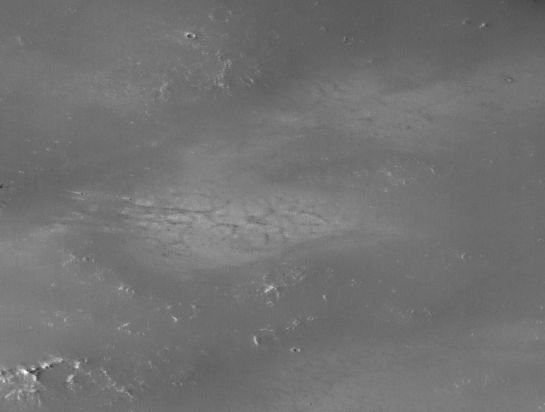
“Look closely. In this Mars Global Surveyor image of the Martian surface just south of Schiaparelli crater, dark lines appear to criss-cross light colored depressions. One tantalizing possibility is simply that the feature near the center is similar to a dried-up lake bed on planet Earth, where light colored mineral deposits are left as water evaporates and cracks are produced as the ground dries. This potential Martian lake bed is roughly 3/4 miles across and may provide further evidence that Mars once possessed surface water. Recently announced results from the Mars Pathfinder mission also point to a Martian past which included a denser atmosphere and surface water - conditions which could have supported life."
Copyright: Public domain
#907 Phi Persei: Double Star December 12, 1997
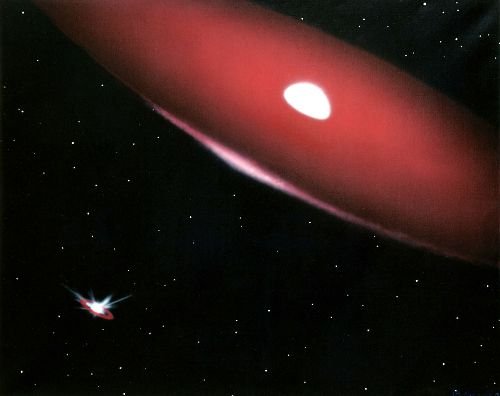
“It's clear who is the biggest star in this binary system. Based on recent results, this artist's vision of the double star Phi Persei, 720 light years away, shows a bright, rapidly rotating massive star surrounded by a disk of gas. A small companion star orbits 100 million miles away. The bigger star is presently about 9 times more massive than the small one ... but it wasn't always this way. Ten million years ago the small companion was actually the most massive star in the system and because of its greater mass evolved into a giant star more quickly. After losing its swollen outer layers to the now massive star, all that remains is a stripped down, intensely hot core of about 1 solar mass. In another ten million years, the roles may reverse as the now massive star swells into its own giant phase "returning" mass to its companion. Will these stars end their lives as white dwarfs or supernovae? Astronomers consider the ultimate fate of such mass-exchanging, interacting binary systems an open question and a challenge for present theories of stellar evolution."
Copyright: Public domain
#908 The Coma Cluster of Galaxies December 13, 1997
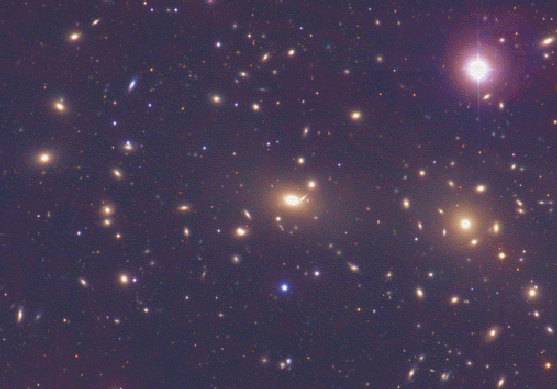
“Almost every object in the above photograph is a galaxy. The Coma Cluster of Galaxies pictured is one of the densest clusters known - it contains thousands of galaxies. Each of these galaxies house billions of stars - just as our own Milky Way Galaxy does. Although nearby when compared to most other clusters, light from the Coma Cluster still takes hundreds of millions of years to reach us. In fact, the Coma Cluster is so big it takes light millions of years just to go from one side to the other! Most galaxies in Coma and other clusters are ellipticals, while most galaxies outside of clusters are spirals. The nature of Coma's X-ray emission is still being investigated."
Copyright: Public domain
#909 The Radio Sky: Tuned to 408MHz December 14, 1997
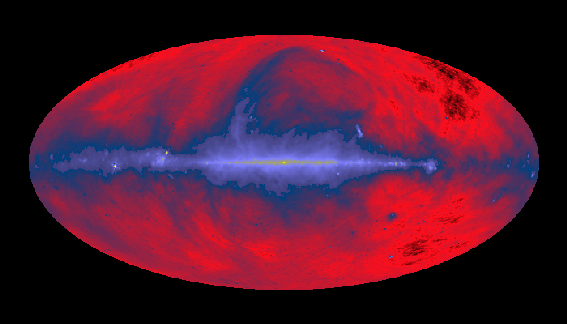
“Tune your radio telescope to 408MHz (408 million cycles per second) and check out the Radio Sky! You should find that frequency on your dial somewhere between US broadcast television channels 13 and 14. In the 1970s large dish antennas at three radio observatories, Jodrell Bank, MPIfR, and Parkes Observatory, were used to do just that - the data were combined to map the entire sky. Near this frequency, cosmic radio waves are generated by high energy electrons spiraling along magnetic fields. In the resulting false color image, the galactic plane runs horizontally through the center, but no stars are visible. Instead, many of the bright sources near the plane are distant pulsars, star forming regions, and supernova remnants, while the grand looping structures are pieces of bubbles blown by local stellar activity. External galaxies like Centaurus A, located above the plane to the right of center, and the LMC (below and right) also shine in the radio sky."
Copyright: Public domain
#910 A Farewell to Tails December 15, 1997
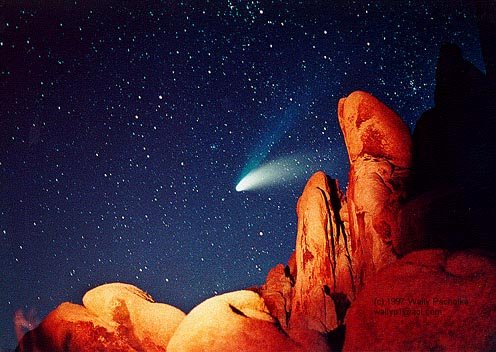
“As 1997 fades, so does the Great Comet of 1997: Comet Hale-Bopp. Discovered even before the Great Comet of 1996, Comet Hale-Bopp became the brightest comet since 1976. Many will remember Comet Hale-Bopp as a comet with a coma so bright it could be seen by eye even when near the Moon. Others will remember spectacular photographs that appeared in magazines and on the web. Amateurs, inspired by the beauty of the comet, took most of these photographs. In particular, today APOD salutes Wally Pacholka, who took the above famous photograph. Mr. Pacholka reports that he repeatedly drove 150 miles to a national park, stayed up half the night, and took hundreds of photos while carefully waving a flashlight to momentarily illuminate the foreground. His equipment consisted only of a standard 35-mm camera which, for pointing accuracy, he piggybacked on a telescope bought at age 12 with money earned from a paper route."
Copyright: W. Pacholka
#911 Night Lightning on Jupiter December 16, 1997

“Why is there lightning on Jupiter? Lightning is a sudden rush of electrically charged particles from one location to another. To create lightning, charges must first separate inside a cloud. On Earth, drafts of colliding ice and water droplets usually create this charge separation, but what happens on Jupiter? Many astronomers theorize that Jovian lightning is also created in clouds containing water ice. To help investigate this, the above photograph was taken in October by the Galileo spacecraft now orbiting Jupiter. Clouds are dimly lit by sunlight reflected off Jupiter's moon Io. The bright flashes appear to originate in active regions at the level where water clouds would exist, and illuminate an even lower cloud level containing ammonia. One thing is for sure: lightning on Jupiter is a lot brighter than lighting on Earth."
Copyright: Public domain
#912 Stonehenge: Ancient Monument to the Sun December 17, 1997

“Stonehenge consists of large carved stones assembled about 4000 years ago. Long before modern England was established, ancient inhabitants somehow moved 25 ton rocks nearly 20 miles to complete it. From similar constructs of the era, people could learn the time of year by watching how the Sun and Moon rose and set relative to accurately placed stones and pits. The placement of the boulders at Stonehenge, however, is not impressively accurate by today's standards, nor even by the standards of that time. Therefore, modern scholars interpret Stonehenge as a colossal monument to the Sun in celebration of the predictability of the seasons."
Copyright: Clive Ruggles
#913 Gamma-Ray Burster December 18, 1997
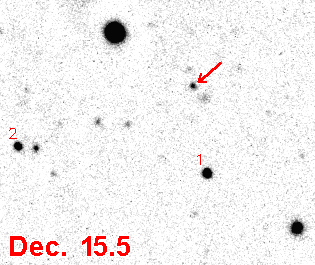
“Gamma-ray bursts seem to be the most powerful explosions in the Universe. Yet their sources continue to elude researchers who stand in awe and frustration at the bursts' transient, enigmatic behavior. The blinking gif above illustrates the latest hard-won result in the quest to identify and understand the nature of the bursters. These Apache Point Observatory optical images from Monday and Tuesday this week have helped identify a faint, fading object (red arrow) near the position of a gamma-ray burst. The gamma-ray burst triggered satellite observatories on Sunday, December 14th. Faint stars near the constellation Ursa Major (the Big Dipper) also appear in these "negative" images of the sky. Though thousands of bursts have been detected by satellites sensitive to gamma rays, it is likely that this object represents only the third known optical counterpart to a gamma-ray burst."
Copyright: Public domain
Upvote! Resteem! Comment! As you like it! Thank you for attention!